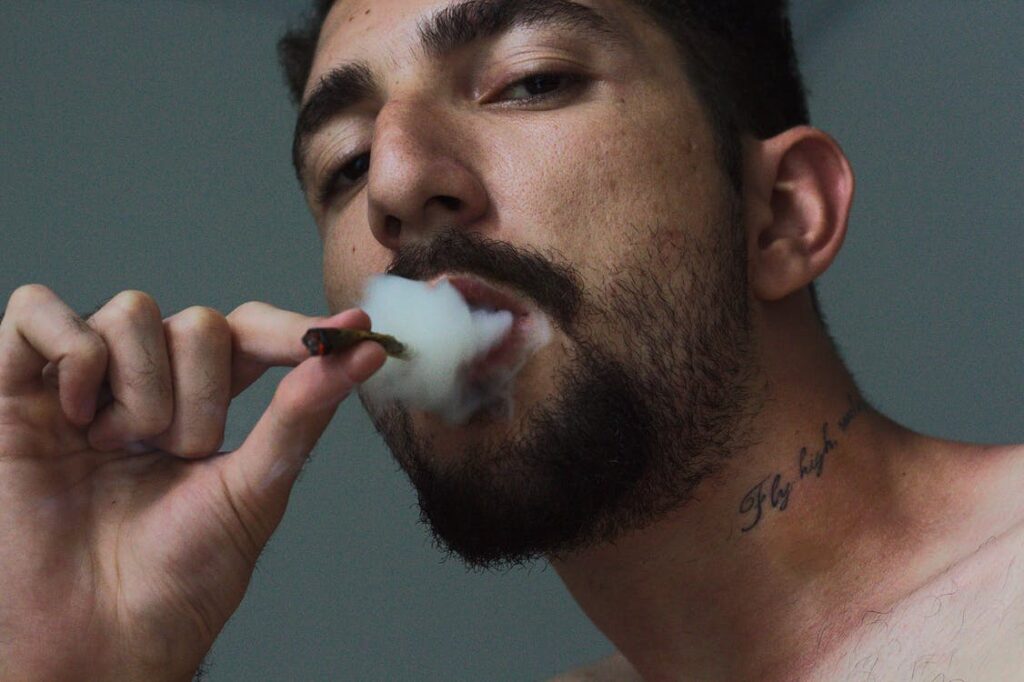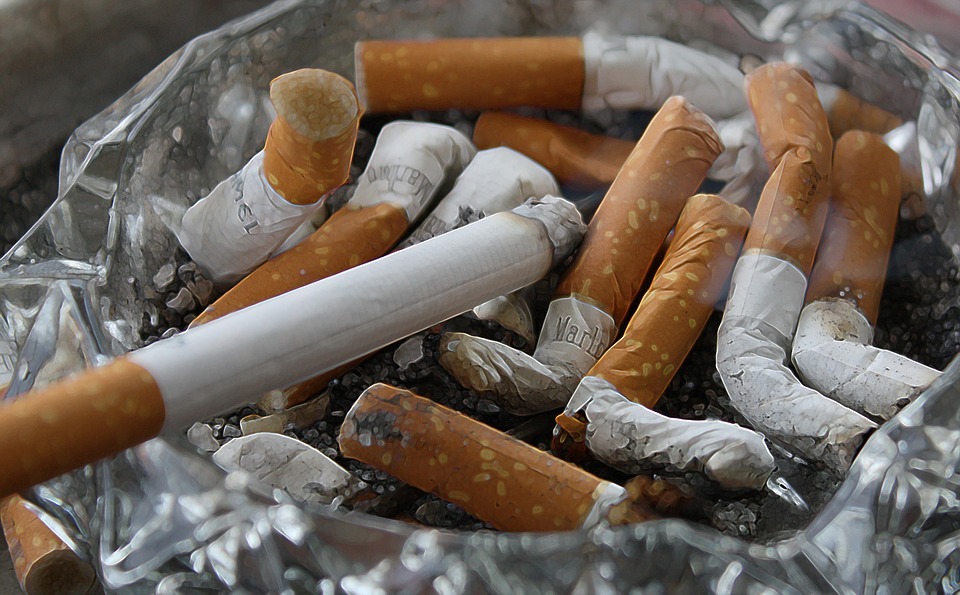Skin and hair are most prone to various environmental toxic substances. Besides the UV rays of the sun, tobacco smoke is a major contributing agent of skin impairment. Tobacco contains hundreds of noxious substances, which are termed “mutagens” and “carcinogens.”
Beyond its association with heart diseases, lung disorders, and cancer, smoking is also linked to causing premature aging of the skin, retarded wound healing, and increased susceptibility to serious infections. Furthermore, a number of skin disorders like psoriasis, hidradenitis suppurativa, and cutaneous lupus erythematosus are the major side effects of smoking.
It is a common observation that therapy causes slower progress in smokers than non-smokers. Also, the severity rate of inflammatory skin diseases in smokers is higher in smokers than in non-smokers. If a person is already having symptoms related to any skin disease, smoking tends to worsen it.
List of Toxic Compounds in Cigarette Smoking
With every puff you take, a number of toxic substances enter your bloodstream. Some of which are listed below:
Carcinogens
- Benzene
- Vinyl chloride
- Formaldehyde
Toxic Metals
- Arsenic
- Cadmium
Radioactive Toxic Metals
- Polonium
- Lead
Poisons
- Ammonia
- Carbon monoxide
- Hydrogen cyanide
- Nicotine
How Smoking Damages the Skin?
Cigarette smoking is responsible for the generation of free radicals caused by the toxins present in the smoke. These free radicals then cause oxidative stress, which results in oxygen insufficiency. Due to this, inadequate oxygen is supplied to the skin, resulting in tissue ischemia and blood vessel occlusion.
Temporary or permanent damage to the skin is also caused by the suppression of the immune system. As a result of which metalloproteinase MMP-1 enzyme degrades collagen.
Free radical generation also results in increased chances of oral cancer, alopecia, and gum diseases.
Smoking and Its Harmful Effects on Skin
If you are a smoking addict but don’t want to ruin your skin, you can get great information through this article. So, let’s explore some serious skin ailments caused by smoking and how to reverse them:
-
Premature Ageing and Deep Wrinkles
The noxious substances within cigarette smoke are responsible for deep wrinkles and premature aging of the skin. This is because these toxins damage the collagen and elastin-fibrous substances within the body that holds the skin together. Due to abrupt collagen and elastin, your skin becomes hard and less elastic.
Wrinkling appears way earlier in a smoking addict person than it does for a non-smoker. Sagginess can be observed, especially below the eyeballs and around the jawline. While deep wrinkles are more visible on the face, especially around the mouth, lips, and eyes.
How Does Smoking Cause Ageing of Skin?
The exact mechanism is unknown, but multiple factors contribute to the onset of early aging of the facial skin, involving:
- The heat from the cigarette tends to burn the skin
- Abrupt collagen and elastin of the skin
- Vasoconstriction – thinning of blood vessels, which cause an insufficient supply of blood to the skin and causes permanent or temporary changes
- Lower levels of vitamin A
- Increased production of free radicals
- Decreases moisture of the skin
-
Impaired Wound Healing
Smoking delays the process of wound healing, which includes mainly skin injuries and major surgical wounds. Even minor wounds and cuts will take a longer treatment duration if you are a heavy smoker. Scarring after minor injuries is also the most common adverse effect of cigarette addiction. This is why the doctors ask to quit smoking before a major surgical procedure; otherwise, smoking can interfere with the healing process of an incision within the skin.
How Does Smoking Cause Delayed Wound Healing?
Smoking increases the risk of infections on the wounds, death of tissues (called necrosis), and formation of tiny blood clots, which ultimately block the small vessels.
The reason for nicotine disturbing the healing process is not specific but involves a combination of multiple factors, including:
- Vasoconstriction, and so inadequate supply of oxygen and other nutrients to damaged cells
- Reduced collagen synthesis, which results in the disturbance of normal inflammatory mediators involved in wound healing.
- Delayed growth of healthy new cells and blood vessels onto the wounded surface
- Delayed migration of keratinocytes
-
Saggy Skin
Sagging of skin is not restricted to the facial area alone, but it also occurs on a person’s upper arms and thus makes the skin baggy. Women’s breasts are also affected.
Mechanism of Action
Skin loosening is because of elastosis – degenerative changes of dermal tissues.
1. Psoriasis
It is an inflammatory disorder that leads to the production of red, itchy patches on the skin surface. Smoking is a major culprit for the development of psoriasis. The greater the smoking addiction, the higher will be the tendency of psoriasis occurrence.
Not only psoriasis, but smoking may double the chances of getting another form of it, called Palmoplantar pustulosis, which is associated with chronic flare-ups. This disease is more common in heavy smokers than non-smokers.
How Does Smoking Cause the Development of Psoriasis?
Smoking lowers the quality of life and causes psoriasis by the following mechanisms:
- Smoking promotes the generation of inflammatory mediators.
- It also induces keratinocyte proliferation.
- Nicotine attaches itself to keratinocytes, T-cells, and dendritic cells.
2. Acne Inversa
The medical term for acne inversa is Hidradenitis suppurativa (HS). It refers to the inflammatory condition of the skin, which produces lesions on the areas where there is friction between the skin, for example, armpits, groin, and under the breasts of females.
Cigarette smoking is considered one of the major environmental causes of acne inversa flare-ups.
3. Skin Discoloration
Skin pigmentation is another adverse effect of smoking. The habit of holding cigarettes between the same fingers repeatedly turns the respective area of skin yellowish because of nicotine and other noxious substance, called tar, present within the smoke.
Mechanism of Action
The skin discoloration is because of the increased production of melanin (natural skin pigment). Enhanced melanin causes dark spots, especially in the facial region.
4. Stained Fingers
The nicotine within the smoke is not only responsible for yellow teeth but also causes yellow stains on fingers and nails. This yellowing is because of the repeated holding of cigarettes in the same position. People with tear-stained fingers are usually more prone to developing smoking-related ailments.
5. Skin Cancer
Smoking doubles the risk of developing the second most common form of skin cancer known as Squamous Cell Carcinoma (SCC) compared to non-smokers. It usually occurs on the lips of heavy smokers. The main cause behind its growth is cigarette smoke.
Oral cancer and oral leukoplakia are commonly seen in smoking-addicted people. Once you develop lip cancer and quit smoking, the recovery can become easier, and the cancer proliferation to other various organs of the body can be restricted by 2 to 3 folds.
Make sure you immediately consult your doctor in case you get any of the following symptoms, as these are alarming signs for the underlying cause of oral squamous epithelial carcinoma:
- Lump on the lip or mouth
- Pain within the oral cavity
- Sore throat
- Difficulty in chewing and swallowing
- Trouble moving jaw or tongue
- Change in voice
- Weight loss
- Numbness in mouth
- Lump in neck or throat
6. Stretch Marks
As nicotine damages the elastin and collagen, the body loses its elasticity and strength. Therefore, stretch marks are another side effect of heavy smoking.
Stretch marks are scars that develop as a result of rapid weight loss or rapid weight gain. Anyone gaining weight is prone to develop stretch marks, but cigarette smoking increases the risk tendency in general.
How Can You Reverse the Effects of Smoking on Skin?
The initial step to reverse the damaging effects on the skin is to quit smoking. Once you overcome the addiction to cigarettes, it will become easier to inverse the effects in the following ways:
- An antioxidant-rich diet is essential to destroy unwanted free radicals. For this, include carrots, spinach, sweet potato, citrus fruits, kiwis, mangoes, tomato, broccoli, and vitamin A, B, B5, K, and C in your diet.
- As per the researchers, a diet including tomatoes and fruits can reverse the damaging effects of smoking on the lungs.
- Carrot Juice can excrete all the traces of nicotine from the body. Practice drinking it daily.
- Likewise, berries are good for the removal of tobacco toxins from the body.
- To counter the dehydration caused by smoking, stay well hydrated.
- Pomegranate is the best fruit to enhance blood circulation, as it was disturbed by vasoconstriction.
- For synergistic effect, use skincare products that contain glycolic acid and alpha hydroxy acid.
How Can You Get Help to Quit Smoking?
If you are struggling to stop smoking, there are a few services and people who may help you with this:
- Talk to your physician. Most doctors can help and instruct information about stopping smoking.
- Nicotine Replacement – patching, nasal spray, lozenges, or inhalers containing nicotine may help in the first few weeks. High loading doses are required for heavy smokers or chain smokers.
- Your doctor may prescribe you Nicotine Agonist Medications that may help you break your habit.
- Services provided by pharmacists, hypnotherapists, acupuncture, and natural therapists are other options for help.
Conclusion
Smoking damages nearly every organ of the body. It is not only our skin that is affected, but smoking also damages the lungs, heart, and kidneys.
If you are a chain smoker or a regular smoker, and you notice your skin starting to suffer, make sure to talk to your doctor about different ways to manage the symptoms as well as aids to stop smoking. The best part is the skin will start recovering on its own after the withdrawal.





